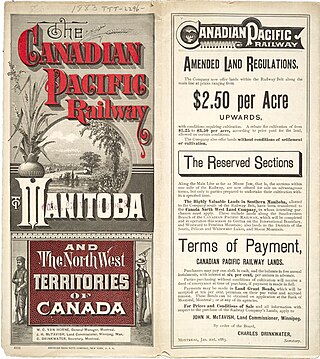
The Evangelical Lutheran Church in Canada is Canada's largest Lutheran denomination, with 95,000 baptized members in 519 congregations, with the second largest, the Lutheran Church–Canada, having 47,607 baptized members. Together with the LCC and the Canadian Association of Lutheran Congregations, it is one of only three all-Canadian Lutheran denominations. It is a member of the Lutheran World Federation, the Canadian Council of Churches, the World Council of Churches, and the Anglican-Lutheran North American grouping Churches Beyond Borders. According to the 2021 Canadian census, a larger number of 328,045 adherents identify as Lutheran.

German Canadians are Canadian citizens of German ancestry or Germans who emigrated to and reside in Canada. According to the 2016 census, there are 3,322,405 Canadians with full or partial German ancestry. Some immigrants came from what is today Germany, while larger numbers came from German settlements in Eastern Europe and Imperial Russia; others came from parts of the German Confederation, Austria-Hungary and Switzerland.

Ukrainian Canadians are Canadian citizens of Ukrainian descent or Ukrainian-born people who immigrated to Canada.

Polish Canadians are citizens of Canada with Polish ancestry, and Poles who immigrated to Canada from abroad. At the 2016 Census, there were 1,106,585 Canadians who claimed full or partial Polish heritage.
Croatian Canadians are Canadian citizens who are of Croatian descent. The community exists in major cities including the Greater Toronto Area, Hamilton, Ottawa, Vancouver, Victoria, Calgary, Edmonton, Winnipeg, Windsor, Montreal and Waterloo Region.

Vietnamese Canadians are Canadian citizens of Vietnamese ancestry. As of 2021, there are 275,530 Vietnamese Canadians, most of whom reside in the provinces of Ontario, British Columbia, Alberta, and Quebec.

Finnish Canadians are Canadian citizens of Finnish ancestry or Finns who emigrated to and reside in Canada. In 2016, 143,645 Canadians claimed Finnish ancestry. Finns started coming to Canada in the early 1880s, and in much larger numbers in the early 20th century and well into the mid-20th century. Finnish immigration to Canada was often a direct result of economic depressions and wars, or in the aftermath of major conflicts like the Finnish Civil War. Canada was often chosen as a final destination because of the similarity in climate and natural conditions, while employment in logging or homesteading attracted landless farmers in the early 20th century. Migratory movements of Finns between Canada and the United States was very common as well.

Esterhazy is a town in the south-eastern part of the Canadian province of Saskatchewan, 83 kilometres (52 mi) south-east of Yorkton along Highways 22 and 80. The town is in the Rural Municipality of Fertile Belt No. 183.
Romanian Canadians are Canadian citizens of Romanian descent or Romania-born people who reside in Canada.

A block settlement is a particular type of land distribution which allows settlers with the same ethnicity to form small colonies. This settlement type was used throughout western Canada between the late 19th and early 20th centuries. Some were planned and others were spontaneously created by the settlers themselves. As a legacy of the block settlements, the three Prairie Provinces have several regions where ancestries other than British are the largest, unlike the norm in surrounding regions.

The community of Serbian Canadians includes Canadian citizens of Serb ethnicity, or people born in Serbia who permanently reside in Canada. Serbs have migrated to Canada in various waves during the 20th century. Today there are five or more generations of Serbs in the country. The 2021 census recorded 93,360 people in Canada declaring themselves as "Serbian". Serbian Canadians generally belong to the Serbian Orthodox Church and follow the Eastern Orthodox tradition.
European Canadians are Canadians who can trace their ancestry to the continent of Europe. They form the largest panethnic group within Canada.

Christianity is the most adhered-to religion in Canada, with 19,373,330 Canadians, or 53.3%, identifying themselves as of the 2021 census. The preamble to the Canadian Charter of Rights and Freedoms refers to God. The French colonization beginning in the 17th century established a Roman Catholic francophone population in New France, especially Acadia and Lower Canada. British colonization brought waves of Anglicans and other Protestants to Upper Canada, now Ontario. The Russian Empire spread Orthodox Christianity in a small extent to the tribes in the far north and western coasts, particularly hyperborean nomads like the Inuit. Orthodoxy would arrive in mainland Canada with immigrants from the eastern and southern Austro-Hungarian Empire and western Russian Empire starting in the 1890s; then refugees from the Soviet Union, Eastern Bloc, Greece and elsewhere during the last half of the 20th century.
Otthon is an unincorporated community in the Canadian province of Saskatchewan.
The Hungarian settlements in North America are those settlements, which were founded by Hungarian settlers, immigrants. Some of them still exist, sometimes their names were changed. The first greater Hungarian immigration wave reached North America in the 19th century, the first settlements were established at that time.

The Rural Municipality of Fertile Belt No. 183 is a rural municipality (RM) in the Canadian province of Saskatchewan within Census Division No. 5 and SARM Division No. 1.
Albanian Canadians are Canadians of full or partial Albanian ancestry and heritage in Canada. They trace their ancestry to the territories with a large Albanian population in the Balkans among others to Albania, Italy, Kosovo, North Macedonia and Montenegro. They are adherents of different religions and are predominantly Muslims.

Yugoslav Canadians are Canadians of full or partial Yugoslav ancestry. At the 2016 Census, the total number of Canadians whose origins lie in former Yugoslavia, majority of whom indicated specific ethnic origin, was 386,340 or 1.12% of the total population.



















